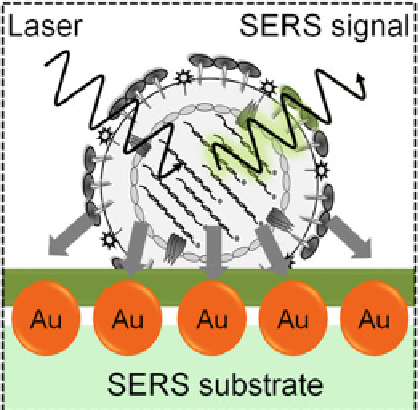Environmental Engineering Reference
In-Depth Information
For the formation of sandwich complex, the antibodies must have different
binding sites for the target to avert competition but in certain cases, sandwich can
still form owing to the formation of trimer by HA molecules. AuNPs also function
to enhance the signal amplification in ICT. Mori et al. [
41
] used 50 nm AuNPs and
have amplified the signal using silver particles
μ
>
10
M, which improved the
sensitivity up to 1,000-fold.
11.4 AuNP-Facilitated Label-Free Sensors
To enhance the sensitivity, AuNPs have been used in conjunction with many label-
free sensors such as surface plasmon resonance, surface-enhanced Raman scatter-
ing (SERS) and waveguide mode. SERS is a phenomenon in which frequency of the
incoming light is similar to the frequency of the scattered light (Fig.
11.6
). The
SERS effect can be enhanced in the presence of AuNP by up to 10
14
orders of
magnitude [
43
-
47
]. SERS was applied for the multiplex detection of
S. typhimurium
and
S. aureus
in complex food matrices. Using silica-coated
magnetic probes as the platforms which are immobilized with antibodies, detection
of bacteria was achieved via AuNPs functionalized with a Raman reporter with a
detection limit of 10
3
CFU mL
1
[
48
].
Surface Plasmon is the excitation of the surface Plasmon by incident light which
happens under the condition of total internal reflection [
49
]. The conjugation or
interaction of the biomolecules with the corresponding target will change the
frequencies of the free electrons on the surface, which can be monitored in real
time. Due to the high dielectric constant of AuNPs and electromagnetic coupling
between AuNPs and the metal film on the surface, the sensitivity of the surface
Fig. 11.6 AuNP in
Surface-enhanced Raman
scattering (SERS)-based
detection. Specific probes
immobilized on the sensor
surface interact with the
virus or other molecule,
thereby shifting the SERS
spectra

